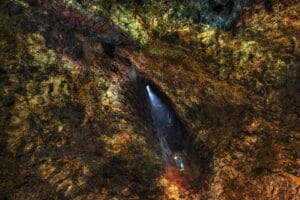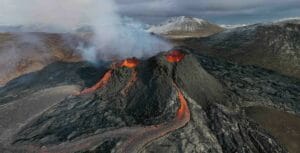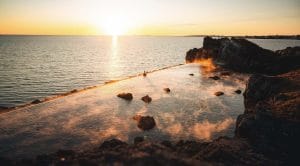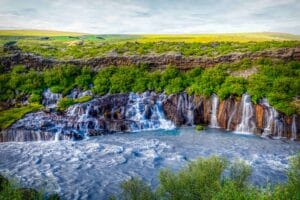Avoiding crowds has never been so important as today. The COVID-19 pandemic has caused a worldwide disruption that has impacted everyone’s life. Social distancing, covered faces have become new normal. The world’s major tourist destinations are currently empty. It doesn’t mean that the situation will remain the same forever. The world is getting ready for travelers; the summer is approaching.
Iceland becomes a busy tourist destination in the summer. People around the world come to see the majestic landscape and breathtaking beauties that this island has to offer. Although Iceland’s major attractions are presently devoid of human presence, the situation is surely going to change in the coming months. The Iceland tourism sector is all geared up with safety measures to welcome visitors. But if you are worried about crowded spots in Iceland, or if you would just like to be all alone in with nature when visiting all the beautiful locations that are to be found in Iceland, here are some useful tips to avoid crowds.

Is Iceland crowded?
The secluded Island on the North Atlantic Ocean is home to a little over 300.000 people. An Island almost the size of England has just 340,00 people. The majority of the population lives in the capital city, Reykjavik. Although each year more than 2 million tourists outnumber the native Icelanders, the country except the capital area remains largely devoid of tourists. When you compare this figure with 85 million annual tourists visiting France, or a much smaller Hawaii with 10 million, it becomes clear that there are still plenty of uncrowded places to explore in Iceland.

1. Set your expectations right
You can’t be the only person at any popular tourist spot in the world. It would be unrealistic to expect that you can have a romantic dinner with your soulmate all alone on the doorstep of the Eiffel Tower. In comparison to Times Square or Sistine Chapel, even Reykjavik’s shopping streets are not crowded at all. As the capital area hosts almost two-thirds of the country’s population, it is surely more crowded than the East fjords, or west Iceland. But it is not overcrowded. The busiest shopping district, Laugavegur, is a single street that draws the majority of pedestrian traffic. So it can seem overcrowded. But think what a shopping street would look like without a crowd. If something is famous, it will draw attention. The major tourist attractions like the Golden Circle, Gullfoss, Geysir, and the Blue Lagoon are going to be relatively crowded. But once you set your expectations right, you are going to enjoy these popular spots.
2. Visit Iceland in Offseason
In Iceland, summers are short, winters are long. Iceland becomes a favorite destination in the short-lived summer months, from mid-May to August. On the other hand, winters last from October to March/April. While the summers are considered high season in Iceland, many tourists visit Iceland in the winter season mainly to witness magical Northern Lights. If you want to have a relaxed experience without many fellow tourists, plan your tour in the offseason months. Between November and March, Iceland becomes a less ‘touristy’ destination. But during these months, Iceland gets cold and devoid of sunlight.
Iceland’s Travel Season
● Summers: Peak-Season
The bulk of foreign tourists visit Iceland in summers (June to August). This is when the days become longer, allowing visitors to enjoy the beautiful Icelandic landscape and outdoor adventures in the sunlight. But this is also the season when popular attractions become crowded, even accommodations can be expensive.
● Spring and Autumn: Shoulder Season
Spring: From mid-April through mid-June is the spring season in Iceland. With the arrival of spring, nature awakens from its winter solitude. Savvy travelers flock during these months to score a travel deal before the arrival of summer tourists. Visitors can expect less crowded and lower accommodation prices at some locations. The shoulder season provides an opportune time for whale watching, horse riding, and the best time for self-driving tours.
Autumn: With the arrival of the autumn/fall season (September to October), the temperature begins to dip although daylight hours remain still normal. It is the time when the Icelandic cultural calendar is filled with numerous art, music, and film festivals including Iceland Airwaves (annual music festival). This time of the year, Iceland becomes less crowded. Nevertheless, adventure activities and cultural festivals remain in full swing throughout autumn.
● Winters: Low Season
Despite being closer to the Arctic, the average temperature in Iceland doesn’t fall below -0.5 degrees Celsius. Days become shorter and often dark. A few tourist attractions especially outside of Reykjavik get closed. However, this is also the best time to see the Northern Lights. Horseback riding, glacier adventures, outdoor swimming, and other outdoor activities continue to attract a handful of brave tourists. Winters can be the best time for those looking for an uncrowded and solitary vacation.

3. Decide your Travel Purpose
If you know the purpose of the visit, you will also know what to expect from that visit. Are you going sightseeing or to see the northern lights? Or maybe both. Whether you want to save money and go to the natural hot springs, or bathe in the Blue Lagoon, it’s important to set your expectations right. Few examples have been listed below.
- Northern Lights: It’s magical, isn’t it? If you want to see the Northern Lights on your Iceland trip, winter is the best time to visit. The small population and long distances between towns make Iceland an ideal place to witness this wonderful naturally occurring phenomena. To Polar Lights occurring, a set of favorable weather conditions needs to be met. Clear sky, cold weather, dark night, and solar flares set the right condition for aurora. And all these conditions are rightly met in winters especially during October and November months. Additionally, the winter is the lowest tourist season. You don’t have to think about the crowd and expensive hotels in winters, just you and magical Aurora Polaris.
- Sightseeing: Whoever made the world, Iceland is his best creation. This North Atlantic island is endowed with an illustrious landscape, fjords, geysers, volcanoes, and spectacular waterfalls. While any season is right to visit Iceland, the summer months are best for sightseeing. In summers, the roads are open and easily accessible, days are warmer and longer. As summers are the peak season, avoiding crowds can be difficult. So don’t mind if you find fellow travelers taking the same road as you. Visiting in autumn is certainly a good idea to avoid the pick season tourists.
- Whale watching: Interested in aquatic life. Even though you can see the whales in Iceland all seasons, the best time to see orca whales also falls in the peak season. June, July, and August months are best for whale watching. There are plenty of tours available from the southern coast of Iceland and from the capital itself. What about winters? Many tourists choose winters for whale watching to avoid the crowds.
- Blue Lagoon: Blue Lagoon is Iceland’s number one major attraction. In summers, especially July and August months register the highest number of visitors. The Lagoon is less crowded in winter. Blue Lagoon is known for its rejuvenating effect on human bodies, and warm seawater just enhances the spa experience. The best time to visit Blue Lagoon is around 3 to 4 PM (10 AM to 2 PM are peak hours). It remains open until midnight in summer months, late evening can also be considered for peaceful geothermal spa-time. Although the Blue Lagoon is more famous than other geothermal spas, other alternatives such as Fontana Spa in Laugarvatn and Geosea Spa up north in Húsavík, are not a bad choice either.

4. Take unbeaten paths
Iceland’s incredible beauty is not limited to just Golden Circle or the south coast. There is much more to explore in the land of Ice and Fire! West Iceland and Snaefellsnes peninsula are wonderful day-long alternatives out of Reykjavik. Driving on 800 km long Ring Road can also be a fulfilling experience for those who love to take long road trips. You will find plenty of locations along the Ring Road that are hidden from the regular tourists. The journey around the Ring Road takes around 6-10 days and while driving you will pass many hidden, untouched gems of Iceland, away from the crowd. If you want to have what it feels like entire fjords to yourself, visit Westfjords or north-west Iceland. Many tourists have now started to visit here but still the majority of the year it remains relatively less crowded. East Iceland holds some of the best natural treasures, from Iceland’s biggest mountains and gushing waterfalls to numerous lakes and geysers, but because of its long distance from Reykjavik, not many tourist visit this area. Additionally, the east region remains relatively untouched from major tourist influxes.
5. Start Early
This is true not only to Reykjavik but almost every major metro city around the world. It’s a good habit to wake up early. Hit the road early especially during the summers. The days are usually long and there is plenty of sunlight even during the night in summer. You can beat the morning traffic and be out of the city long before others finish their morning coffee. A little search about the area where you are visiting, gas stations, and restrooms will help you to plan a hassle-free journey.
6. Schedule a midnight visit
Why not take advantage of longer daylights in summer? Iceland has 24-hours daylight in the summer months. While a majority of the tourist spots get crowded between 10 to 6 AM, the time before and after them remains calm, devoid of a large crowd. And during the Midnight Sun, some places have a very different atmosphere which may not be felt during regular hours. 60 m Seljalandsfoss Waterfall in Southern Iceland looks just more stunning during Midnight Sun. The waterfall is less than 2 hours drive from Reykjavik. So you can easily visit and come back if you were self-drive. Another waterfall, Glymur is not far from the capital and perfectly suited for a Midnight excursion. Located in the beautiful landscapes of Hvalfjörður, the waterfall drops 198 m straight from the top of a mountain. There are numerous other hotspots in Iceland that you can enjoy in the Midnight Sun.

7. Plan your journey on weekdays
Although Iceland doesn’t share land-boundaries with any country, many tourists from Nordic countries and the UK flock here during the weekends for a short trip. During the weekends, the Icelandic streets tend to be busier and crowded in summers. So if you plan your trip around weekdays, it is less likely that your favorite spots will be crowded.
8. Take your time
Many visitors try to cover must-see places in just a couple of days. Those tourists visit their favorite spots, click a few selfies around the waterfall or mountains, and rush for another spot. In this way, they might be able to complete the tour in stipulated time and put pictures on Instagram. Take your time to get immersed in nature, listen to the cold winds, talk to mountains, or hike to the top of a mountain. Do the things you love rather than rushing from one place to another. A much better approach will be to select fewer spots and scheduling enough time for each spot to truly enjoy visiting those places. Early morning or late evening walks around the popular destinations tend to be less crowded.
9. Go for Hiking
It’s a sure way to avoid the crowd. Hiking can be physically demanding but worth the effort. Pick a spot from your bucket list and take a short hike if not up for a day-long or multi-day hikes. While driving is all fun, hiking puts you closer to nature. Moreover, you will find a handful of people on your hiking trails. Even in some of the best tourist spots such as Vatnajokull and Þingvellir National Parks, the trailing paths remain less crowded. The best time to go hiking is perhaps in the morning when these spots remain almost devoid of human presence (except adventurous souls like you).

10. Travel in a small group
Many travel operators offer small group tours. If money is not a concern, you can also choose a private tour offered to some of the best places in Iceland. The big bus tours operating from Reykjavik tend to be crowded. A group tour consisting of less than 12 persons is perfectly suitable to enjoy a comfortable journey and pristine time with nature.
11. Do a little research
Iceland is the second biggest Island in Europe, second only to Great Britain. There are still plenty of beautiful places undiscovered by average tourists. Before arriving, do a little research around places you want to visit. As stated earlier, majestic Westfjords or East Iceland are some of the least visited regions due to distance from the capital and lack of urban facilities. However, with the help of an expert guide, you can discover many hidden wonders of Iceland.
Takeaway
These simple steps will help you avoid the crowd and have a memorable trip. As COVID-19 restrictions are still in place (as of now, when this is written), there is the very least possibility of Iceland getting overcrowded with tourists. Even before the pandemic, the idea of Iceland being crowded is greatly exaggerated. The majority of Iceland’s population lives in Reykjavik, so the capital region will likely get a little crowded with the arrival of summer tourists. However, other regions such as East or West Iceland hardly ever get crowded. Even popular tourist spots are not crowded in the offseason. In winters, Iceland transforms itself into a wonderland – frozen waterfalls, ice-capped peaks, and Northern lights make Iceland truly magical. Hiking is another great way to avoid the crowd. You will find a handful of people even at some of the most popular spots.





















































